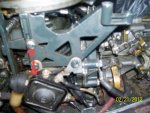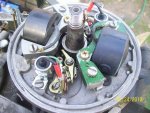Hello all, before posting I've been reading days of 1971 25 hp Johnson posts on the web only to find nothing that describes the strange electrical wires extending out of my motor front plug.
Keep in mind that this motor cranked and ran just fine prior to me trying to rewire the ignition (new terminals, new lanyard switch, new panel). The old panel was wood and rotting and the wires were crumbly in some places. I wasn't about to get on the water like that. Now it just turns over and I can smell fuel as if I'm flooding the thing trying to crank it. The plugs are wet when I check.
The first cable (black) coming from the motor contains a white wire that I haven't gotten to read any voltage from at any point. I'm not sure what prong it's connected to or what it's for, but halfway down this black cable is a black wire inside the cable (next to the white wire)... the black wire is connected to the battery positive, so on the ignition switch side the same black wire is the 12v source for the B terminal on the switch, just so you'll know my 12v is coming from for the ignition switch. I'm not sure but if I had to guess why the black cable containing both a black and white wire doesn't have the inner black wire connected inside the motor itself to a 12v connection, is that there aren't enough prongs on the harness to use for custom purpose, so the person tapped into this black cable near the battery. Either way, 12v is connected to the ignition switch B terminal.
The second cable coming from the motor harness port (grayish) is strange because it starts with an inner green wire and white wire (both connected to pins on the port) but on the ignition switch side there are only 6 white thinner wires, all numbered. For the life of me I can't figure out how this can be. I've been in electronics since I was a kid (43 now) and I am baffled. I've followed the cable, and it goes from green + white thick wires to 6 white thin wires on the other end. I've even cut away and restripped the ignition side quite a bit.
I'm going to call this 2-to-6 cable the Mystery Signal Cable. Already proving that the white ingition side wires 6 and 7 will turn the engine over when connected to 12v, I have wired them to the S terminal on the switch. Turning the key turns the motor over, but no run.
Going into the motor is of course the battery cables, on either side of the harness port opening. Do they not make a plug that fits this port so I can just hook my wires to that so I can disconnect the motor and take it to a repair shop when needed? I find this very odd that all of the wires are hardwired to the motor when there is a port right there on the front for this purpose.
My questions for now are basic... where on earth is a diagram of the harness pins for the 25R71 1971 Johnson outboard so I can unplug those silly cables and reduce everything to one cable if possible that contains 12v, ground (battery), starter wire, and kill switch wire. I just want the darn motor to crank and have a saftey kill switch.
I am posting some pics I took but the camera was a little too close so they are a little blurry. Maybe you can tell what the deal is with the harness wires that are directly connected to the pins.


what's this?

what's these two wires for going underneath the flywheel? they look rather new.
Keep in mind that this motor cranked and ran just fine prior to me trying to rewire the ignition (new terminals, new lanyard switch, new panel). The old panel was wood and rotting and the wires were crumbly in some places. I wasn't about to get on the water like that. Now it just turns over and I can smell fuel as if I'm flooding the thing trying to crank it. The plugs are wet when I check.
The first cable (black) coming from the motor contains a white wire that I haven't gotten to read any voltage from at any point. I'm not sure what prong it's connected to or what it's for, but halfway down this black cable is a black wire inside the cable (next to the white wire)... the black wire is connected to the battery positive, so on the ignition switch side the same black wire is the 12v source for the B terminal on the switch, just so you'll know my 12v is coming from for the ignition switch. I'm not sure but if I had to guess why the black cable containing both a black and white wire doesn't have the inner black wire connected inside the motor itself to a 12v connection, is that there aren't enough prongs on the harness to use for custom purpose, so the person tapped into this black cable near the battery. Either way, 12v is connected to the ignition switch B terminal.
The second cable coming from the motor harness port (grayish) is strange because it starts with an inner green wire and white wire (both connected to pins on the port) but on the ignition switch side there are only 6 white thinner wires, all numbered. For the life of me I can't figure out how this can be. I've been in electronics since I was a kid (43 now) and I am baffled. I've followed the cable, and it goes from green + white thick wires to 6 white thin wires on the other end. I've even cut away and restripped the ignition side quite a bit.
I'm going to call this 2-to-6 cable the Mystery Signal Cable. Already proving that the white ingition side wires 6 and 7 will turn the engine over when connected to 12v, I have wired them to the S terminal on the switch. Turning the key turns the motor over, but no run.
Going into the motor is of course the battery cables, on either side of the harness port opening. Do they not make a plug that fits this port so I can just hook my wires to that so I can disconnect the motor and take it to a repair shop when needed? I find this very odd that all of the wires are hardwired to the motor when there is a port right there on the front for this purpose.
My questions for now are basic... where on earth is a diagram of the harness pins for the 25R71 1971 Johnson outboard so I can unplug those silly cables and reduce everything to one cable if possible that contains 12v, ground (battery), starter wire, and kill switch wire. I just want the darn motor to crank and have a saftey kill switch.
I am posting some pics I took but the camera was a little too close so they are a little blurry. Maybe you can tell what the deal is with the harness wires that are directly connected to the pins.


what's this?

what's these two wires for going underneath the flywheel? they look rather new.






















